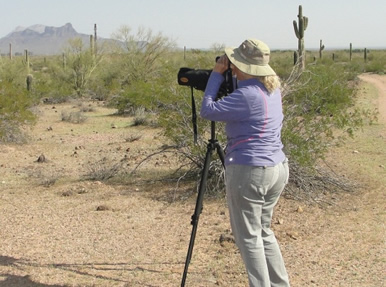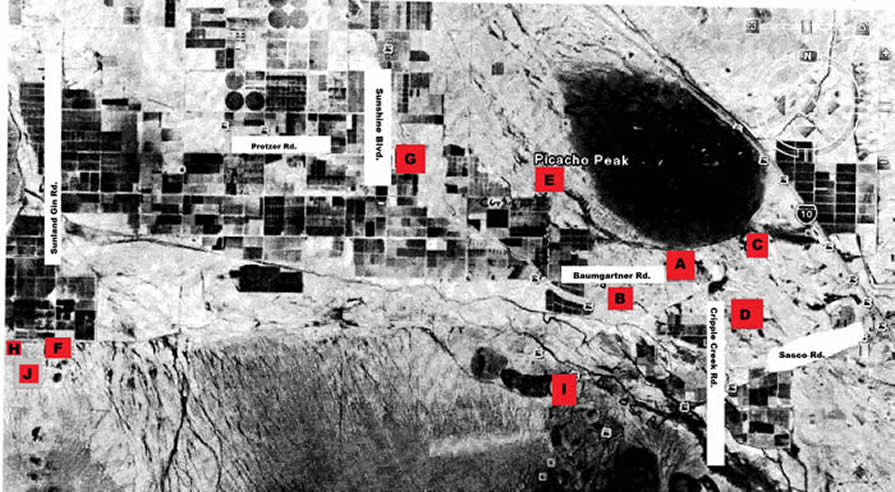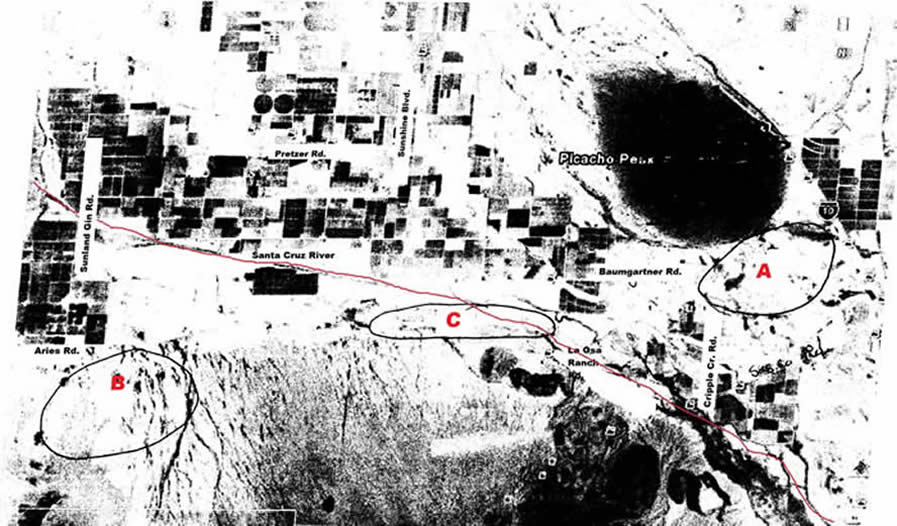 |
 |
|||||||||||||||||||||
|
||||||||||||||||||||||
AZFO FIELD EXPEDITION
Survey for Crested Caracara (Caracara cheriway) Nests on Santa Cruz Flats, Pinal County
March 23, 2013
Doug Jenness
Rich Glinski
(click here for the PDF version of the report)
 |
Adult Crested Caracara--Photo/Marceline VandeWater |
Introduction
The number of Crested Caracaras has been increasing in recent winters on the Santa Cruz Flats, and in smaller numbers they have been reported in every month of the year. Typically this species does not wander far from its nesting
grounds, even in the winter, so the question is: Are they nesting in this area? The objective of this AZFO Field Expedition was to determine if caracaras are nesting on the Santa Cruz Flats, which would document a northward expansion of their nesting range. For the past 50 years, the only part of the state where they have been documented regularly nesting is on the Tohono O'odham lands in southwestern Pima County. In Arizona, nest building for caracaras begins mid-March, and nests are typically built in saguaros (Carnegiea gigantea).
Methods
Thirteen participants were organized into five teams on 23 March to survey an extensive area in the southern part of the Santa Cruz Flats. They met for orientation in Red Rock at 7:00 a.m. and conducted surveys between 8:00 a.m. and 2:00 p.m. for a total of 60.5 observer hours. The teams' focus was to scan areas where the agricultural fields that the caracaras most often use for feeding meet stands of saguaros. This included flat areas bordering the southern and western slopes of Picacho Peak and bordering the northern slopes of the Silverbell Mountains. The teams established observation points, usually at elevated sites, where they scanned large areas with binoculars and spotting scopes for 0.5 to 5.0 hours. They also drove along roads scanning for caracaras and nests. All observers had binoculars, and each team had at least one spotting scope. The teams had a set of satellite maps and survey forms to record their data. The weather conditions were clear and sunny with temperatures ranging from 60° F. in the morning to a high of 80° F. in the afternoon. Later in the morning there were gusty winds of 10-15 mph from the southwest, which in some areas stirred up enough dust to make viewing conditions a bit hazy.
Results
 |
| Nancy Rivera scanning near Silverbell Mtns.- Photo/Doug Jenness |
The teams reported observing a total of at least 17 Crested Caracaras and possibly an additional two. They were seen in five locations.
The largest group was of 12 on the ground and perched in brush piles in a cattle pasture at Cripple Creek and Baumgartner roads where
they have often been seen feeding, including in ones and twos in the summer (Figure 1-A). The 12 all appeared to be first-year birds. The team saw several cattle carcasses and skeletons in the vicinity of the caracaras. After watching the group for 45 minutes, the team saw four birds fly to the southwest toward the Santa Cruz River. The team attempted to follow but lost them. However, they discovered and photographed a single adult bird perched in a mesquite on the edge of a farm field next to the river about 3.0 miles from Cripple Creek and Baumgartner roads (Figure 1-B). The team then returned to where they had seen the group of 12, because they saw a flock of 10 circling birds in that direction, which turned out to be Black Vultures. They then observed two caracaras fly over their heads and land in a tree to the northeast of the Cripple Creek and Baumgartner intersection (Figure 1-C). The team moved closer and set up a new observation point about .75 miles northeast of the intersection where the first observation point was located. This was a more elevated site. However, they weren't able to get another look at the pair of caracaras. The team scanned the area to the northeast for 0.5 hours and discovered four nests in saguaros, one occupied by Red-tailed Hawks and three that appeared inactive. Observers who returned to this area later in the afternoon saw three caracaras perched on saguaros farther north from Baumgartner, closer to the southern edge of Picacho Peak.
Another team, at an observation post .5 miles straight north from the Red Rock feedlot, saw a Crested Caracara about 1.0 mile to the northwest as it flew from the northwest and landed on the ground (Figure 1-D). The team was at this observation post for 2.1 hours.
One more adult caracara was observed by a team stationed for 1.0 hour at Curtis and Wheeler roads (Figure 1-E). The bird was 0.5 miles to the northeast of the observers, i.e. towards Picacho Peak It perched briefly in a mesquite and then dropped to the ground and couldn't be relocated.
The team stationed at the northwestern flank of the Silverbell Mountains observed a bird that it said may have been a caracara flying low along an irrigation canal parallel to Aries Rd. about 0.5 miles west of Sunland Gin Road (Figure 1-F).
No active caracara nests were found. Two nests where caracaras had been seen in the nonbreeding season were checked. The first, located in a mesquite along Pretzer Rd. about .25 miles from Sunshine Blvd., was photographed in January 2012 with a caracara perched on it (Figure 1-G). When the survey team got about 100 yards from the nest by car an unidentified bird flew off of it toward the southeast. Two team members described the bird as having "relatively long legs and white wing patches and a light tail," but were unable to make a definite identification. They waited for 45 minutes to see if the bird would return. During this time a Red-tailed Hawk flew in from the northwest and landed in a branch below the nest. The second nest, photographed and reported in January 2013, is located in a saguaro on the south side of Aries Rd. 0.7 miles west of Sunland Gin Rd. (Figure 1-H). In January two adult caracaras were reported perched atop the saguaro with the nest and skirmished with two Red-tailed Hawks in the vicinity. The survey team found that the nest was occupied by a brooding Red-tailed Hawk.
 |
| Figure 1. Crested Caraca sightings, March 13, 2013 |
Observers discovered several nests that were not actively in use. One in particular had signs that it may have been used by caracaras as recently as last year. It was located in a saguaro south of Osa Ranch Rd. between the Santa Cruz River and the Silverbell Mountains 2.7 miles west of the intersection of Sasco and Osa Ranch Rds. (Figure 1-I). The saguaro with the nest and another nearby had signs of old whitewash that had not been completely washed away by rains. Whitewash on cacti used by caracaras for sentinel posts is typical of nesting caracaras. The nesting materials seemed to be thin, typical of caracaras, but the nest seemed a bit on the large side. Moreover, it was a couple hundred feet up the slope of a bajada and not on the lower, flat desert they prefer. There was insufficient evidence to clearly say it was a caracara nest as opposed to a raven nest, which also might have whitewash associated with it. Another nest in a saguaro was observed southwest of the Aries and Sunland Gin roads intersection not far from the nest that proved to be a Red-tailed Hawk nest and in the vicinity where caracaras have been observed (Figure1-J). A nearby saguaro had whitewash on it. About a mile to the east the bare upper branches of a mesquite was coated with whitewash.
In addition to these two nests three other unoccupied nests were observed. Occupied nests of other raptors were also found, including a total of three Red-tailed Hawk, two raven (sp.), and one Great Horned Owl.
 |
| Figure 2. Locations to conduct follow-up surveys |
Recommendations
Even though no active caracara nests were found, evidence pointing to possible nesting suggests more surveys would be appropriate. Moreover, there was potential nesting habitat that was not surveyed. Three areas stand out as candidates for further surveys. One is the area northeast of the cattle pastures at Baumgartner and Cripple Creek roads (Figure 2-A). Nests were seen in the distance and at least two adult caracaras were seen flying toward this area. One team learned that there is a service road that circumnavigates Picacho Peak inside the state park, which is normally off limits. It begins near the trailhead on the northwest side and ends at the Rooster Cogburn Ostrich Ranch. This route would likely give a fresh vantage point for scanning the northeast edge of the mountain. A special use permit must be obtained to gain access to this road.
A second area is the desert on the northwest flank of the Silverbell Mountains, where whitewash was observed on a saguaro and a mesquite, an unidentified nest was spotted, and a possible caracara was reported flying (Figure 2-B). Watching this nest and setting up another observation point in the area are both warranted.
There is also a strip of desert between the north side of the Silverbell Mountains and the south side of the Santa Cruz River, which remains unexamined (Figure 2-C). Access appears to be possible along a power line access road diverging west from Osa Ranch Road.
A follow-up visit to the nest at Pretzer Rd. and Sunshine Blvd. should also be organized.
Comments
In addition to observing caracaras, the teams reported nine other raptor species, including American Kestrel (6), Northern Harrier (10), Red-tailed Hawk (20), Ferruginous Hawk (2; both first-year birds), Cooper's Hawk (1), Swainson's Hawk (6), Harris's Hawk (1), Black Vulture (16), and Turkey Vulture (many). One team made an interesting incidental observation of a flock of 20 Lark Buntings, a species usually common in the winter in the Santa Cruz Flats, but rarely reported this winter. A special thanks to all those who participated: Brieanna Brown, Dave Brown, Sue Drown, Rich Glinski, Tim Helentjaris, Doug Jenness, Gordon Karre, Sue Kozacek, Cathy LeVine, Norma Miller, Larry Norris, Nancy Rivera, Marceline VandeWater.
|
©2010 |
HOME | | | REPORT SIGHTINGS | | | PHOTOS | | | BIRDING | | | JOURNAL | | | ABOUT US | | | CHECKLISTS | | | AZ BIRD COMMITTEE | | | EVENTS | | | LINKS |